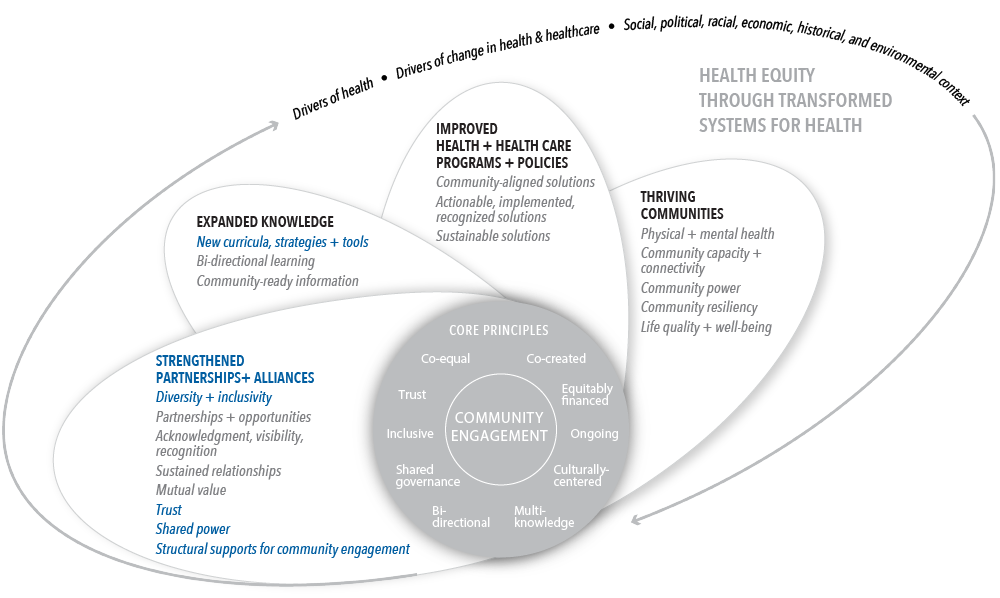Assessing Meaningful Community Engagement
Participant Questionnaire for the Public and Patient Engagement Evaluation Tool
KEY FEATURES
COMMUNITY/ GEOGRAPHY
Community advisory councils, patients, family members, citizens
Health system staff
Patient partner representatives Health system organizations
Ontario, Canada
COMMUNITY ENGAGEMENT OUTCOMES
Strengthened partnerships + alliances
Broad alignment
Diversity + inclusivity
Trust
Shared power
Structural supports for community engagement
Expanded knowledge
New curricula, strategies + tools
PLACE(S) OF INSTRUMENT USE
Community/community-based organization
Hospital, clinic, or health system
LANGUAGE TRANSLATIONS
Dutch (unavailable publicly)
French
German (unavailable publicly)
Italian (unavailable publicly)
PSYCHOMETRIC PROPERTIES
Content validity
YEAR OF USE
2018
2012-2014
Assessment Instrument Overview
The Participant Questionnaire for the Public and Patient Engagement Evaluation Tool (PPEET)1-4 has 26 questions for use by citizen and patient participants in health system engagement activities. It assesses the quality and impact of engagement. The Participant Questionnaire is part of a set of three instruments that also includes the Organization Questionnaire and the Project Questionnaire for the PPEET.
Alignment with Assessing Meaningful Community Engagement Conceptual Model
The questions in the Participant Questionnaire for the PPEET were aligned to the Assessing Community Engagement Conceptual Model. Figure 1 displays the alignment of Participant Questionnaire for the PPEET with the Conceptual Model domain(s) and indicator(s). Where an instrument is mapped broadly with a domain or with a specific indicator, the figure shows the alignment in blue font.
Table 1 displays the alignment of the Participant Questionnaire for the PPEET’s individual questions with the Conceptual Model domain(s) and indicator(s). The table shows, from left to right, the aligned Conceptual Model domain(s) and indicator(s) and the individual questions from the Participant Questionnaire for the PPEET’s transcribed as they appear in the instrument (with minor formatting changes for clarity).
| CONCEPTUAL MODEL DOMAIN(S) AND INDICATOR(S) | ASSESSMENT INSTRUMENT QUESTIONS |
| STRENGTHENED PARTNERSHIPS + ALLIANCES; Broad alignment with all indicators in this domain | I think this activity will make a difference. Overall, I was satisfied with this activity. This activity was a good use of my time. How do you think the results of your participation will be used? What was the best thing about this engagement activity? Please identify at least one improvement we could make for future engagement activities. |
STRENGTHENED PARTNERSHIPS + ALLIANCES; Diversity + inclusivity | A wide range of views on the topic were expressed. |
STRENGTHENED PARTNERSHIPS + ALLIANCES; Trust | The purpose of the activity was clearly explained. I understand how the input from this activity will be used. As a result of my participation in this activity, I have greater trust in [administering organization to insert relevant term, e.g., providers, public and patient engagement staff, organization as a whole, health system, personal competency]. |
| STRENGTHENED PARTNERSHIPS + ALLIANCES; Shared power | I had enough information to contribute to the topic being discussed. I was able to express my views freely. I feel that my views were heard. I feel that the input provided through this activity will be considered by the organizers. |
STRENGTHENED PARTNERSHIPS + ALLIANCES; Structural supports for community engagement | The supports I needed to participate were available (e.g., travel, child care, etc). |
EXPANDED KNOWLEDGE; New curricula, strategies + tools | As a result of my participation in this activity, I am better informed about [administering organization to insert relevant term here, e.g., public and patient engagement issue, organization, health system, other topic of focus]. |
Table 1 | Participant Questionnaire for the Public and Patient Engagement Evaluation Tool questions and alignment with the domain(s) and indicator(s) of the Assessing Community Engagement Conceptual Model
ASSESSMENT INSTRUMENT BACKGROUND
Context of instrument development/use
The articles highlight the importance of public and patient engagement (PPE) in quality improvement efforts and that evaluating PPE often requires a balance between “relevance to practitioner needs” and “application of rigorous methods.”4 The articles discuss the development of PPEET, which leverages a three-year collaboration between Canadian researchers and practitioners.1,4 PPEET “was launched as a simple-to-administer tool intended for use by a wide range of health system organizations to assess the quality and impacts of engagement, with the goal of contributing to both the practice and the science of public and patient engagement.”1 PPEET consists of three questionnaires to evaluate public and patient engagement: the Participant Questionnaire (described here), the Organization Questionnaire (described in another assessment instrument summary), and the Project Questionnaire (described in another assessment instrument summary).
Instrument description/purpose
The Participant Questionnaire of the PPEET allows for capturing participants’ assessment of the key features of the PPE initiative. It evaluates the perspectives of “those participating or partnering in engagement activities and processes,” including patient contributors and partners.1 The Participant Questionnaire focuses on integrity of design and process and assesses two areas:
- Engagement activity
- Satisfaction
The Participant Questionnaire contains 26 questions. It uses a combination of open-ended response options and a five-point Likert scale ranging from “strongly agree” to “strongly disagree.”4
The guidance for administering the instruments and the English and the French translations for the three questionnaires in the PPEET, including the Participant Questionnaire, can be accessed here: https://ppe.mcmaster.ca/resources/public-and-patient-engagement-evaluation-tool/. Please contact [email protected] to request the other language translations.
Engagement involved in developing, implementing, or evaluating the assessment instrument
“A pan-Canadian partnership of PPE practitioners and researchers” with the shared goal of developing a common evaluation tool formed through two consecutive research grants from the Canadian Institutes of Health Research. This research–practice collaborative “included representation from seven provinces, six regional health authorities and two provincial and local health organizations.”4
The development of the tool took place over a three-year period. After a review of the literature, collaborative members engaged using structured e-mail, telephone, and face-to-face exchanges at workshops. A process with iterative rounds of review, also known as a modified Delphi process, was also used to review and prioritize insights. These activities contributed to the “identification of a set of overarching principles for carrying out high quality PPE activities that would serve as the foundation for the evaluation tool.” The workshops used breakout sessions and reporting back to the larger group, as well as larger group discussions, to identify and agree on a core set of outcomes. The core principles were mapped to outcomes and prioritized for inclusion in the tool. After developing “three discrete evaluation questionnaires for three different respondent groups,” the collaborative “tested the usability of the questionnaires preceding final revisions to the tool.”4
Patients and members of the public were only directly involved in the usability-testing phase. Participants, project managers and senior organizational personnel in two health regions tested the usability of the questionnaires.4 The tool underwent “additional feasibility testing in seven health system organizations in Ontario in collaboration with staff and patient partner representatives from each organization.” The PPEET was modified based on the results and the revised instruments, which launched in August 2018, were tailored to the specific respondent groups, had separate modules for different types and stages of engagement “(e.g., one time versus ongoing and planning versus implementation),” and included an increased balance in response options with opportunities for more in-depth follow up.1
Additional information on populations engaged in instrument use
Usability testing for the questionnaires took place with practice partners from two health regions and provinces. “The Participant Questionnaire was distributed to 145 public participants in total including members of community advisory councils, patients, family members and citizens who had participated in various engagement activities; 23 responses were received.”4
Notes
- Area(s) of opportunity: The authors suggest that the focus throughout the process of developing the tool was on user needs (i.e., usability) rather than on psychometric properties, which may have led to a less robust evaluation tool. Since the tool development process was influenced by having short and easy to administer questionnaires, this may have “compromised the tool’s validity (e.g., number and specificity of statements used to assess a particular domain of practice, use of a 5-point vs. a 7-point scale).” Additionally, patient and citizen perspectives were not directly included in the development process for the PPEET beyond the usability testing phase. The PPEET’s focus on the health care context of Canada may limit its generalizability and applicability to “non-Canadian settings and to health-care organizations that focus on smaller and more specialized populations;” however, the extensive international literature review and participating partner organizations from major urban and regional referral centers that informed the tool included large and highly diverse populations.4
- Important findings: The authors indicate that to their knowledge, “this is the first collaboration of researchers and practitioners in the co-design of a comprehensive evaluation tool aimed at assessing the quality and impact of episodic and on-going PPE activities in health system organizations from three distinct perspectives – public and patient participants, sponsors and managers of PPE projects and organizational leaders responsible for PPE.” The tool strikes a balance between “the application of rigorous methods and relevance to practitioner needs,” and the results of the usability testing of the Participant Questionnaire were positive.4
- Future research needed: Additional research and testing of the questionnaires is needed to understand if any weaknesses exist in the PPEET’s validity. Further testing is also needed on the feasibility of applying the tool to every type, level, and degree of PPE.4
- Supplemental information: The modified version of the PPEET, including the Participant Questionnaire, released in 2018, can be accessed here: https://healthsci.mcmaster.ca/docs/librariesprovider61/default-document-library/ppeet-complete-set-final.pdf?sfvrsn=d1617fe6_2. Additional information on other settings this assessment instrument has been used in (i.e., emergency settings), populations in which the instrument has been tested (i.e., children with developmental delays, women with heart diseases) and modifications made can be found in the following articles:
- Ogourtsova, T., M. E. O’Donnell, J. H. Filliter, K. Wittmeier, Bright Coaching Group, and A. Majnemer. 2021. Patient engagement in an online coaching intervention for parents of children with suspected developmental delays. Developmental Medicine & Child Neurology 63 (6):668-674. https://doi.org/10.1111/dmcn.14810.
- Teed, M., J. Ianiro, C. Culhane, J. Monaghan, J. Takacs, G. Arthur, and A. Nash. 2021. Engaging Women With Lived Experience: A Novel Cross- Canada Approach. Journal of Patient Experience 8:1-7. https://doi.org/10.1177/23743735211008300.
- Bhati, D. K., M. Fitzgerald, C. Kendall, and S. Dahrouge. 2020. Patients’ engagement in primary care research: a case study in a Canadian context. Research Involvement and Engagement 6:1-12. https://doi.org/10.1186/s40900-020-00238-x.
- Drebit, S., K. Eggers, C. Archibald, R. Abu-Laban, K. Ho, A. Khazei, R. Lindstrom, J. Marsden, E. Martin, and J. Christenson. 2020. Evaluation of Patient Engagement in a Clinical Emergency Care Network: Findings From the BC Emergency Medicine Network. Journal of Patient Experience 7(6):937-940. https://doi.org/10.1177/2374373520925721.
- Thompson, A. P., S. E. MacDonald, E. Wine, and S. D. Scott. 2020. An Evaluation of Parents’ Experiences of Patient Engagement in Research to Develop a Digital Knowledge Translation Tool: Protocol for a Multi-Method Study. JMIR Research Protocols 9(8). https://doi.org/10.2196/19108.
We want to hear from you!
Assessing community engagement involves the participation of many stakeholders. Click here to share feedback on these resources, or email [email protected] and include “measure engagement” in the subject line to learn more about the NAM’s Assessing Community Engagement project.
Related Products


